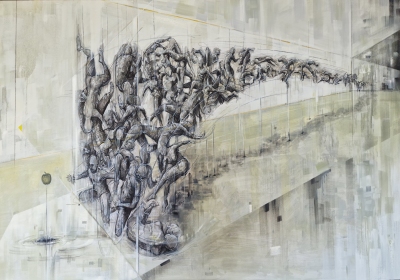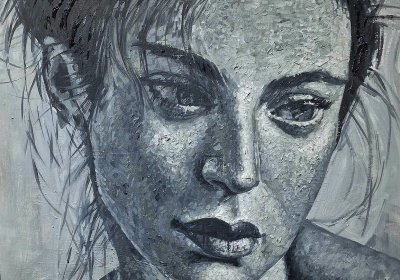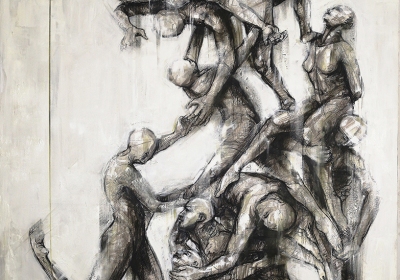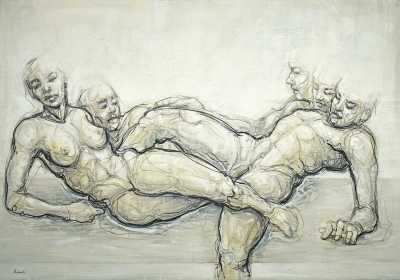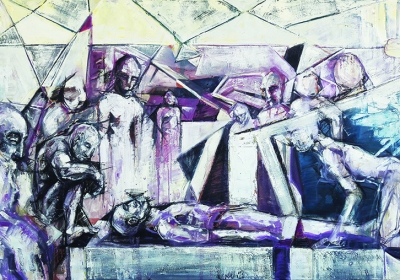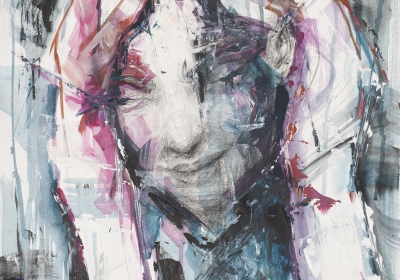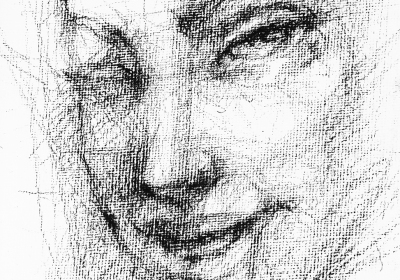‘’Cosmos’’ The Unseen, presents stories, emotions and expressions that cannot be seen with naked eye. The exhibition is a presentation of the untouchable inner world of human kind – Cosmos. Moments, feelings and memories have no form. They are untouchable ideas that whirl in our minds. They do not have a facade or and particular form of shape and volume. Beyond the realistic skin of the human body there is an unseen world of our inner expressions. ‘’ I am going to paint realism but I am gonna have fun’’ - Aristos.C
24 Photos
It is generally accepted that portrait paintings refer to those works inspired usually by the creation of objective realistic images. In Aristos’ portraiture, even though his original motive for making them is a personal aesthetic satisfaction, at the end, most of them are recollections, or simply a “collage” of people, he has encountered personally or in photographs. The result, is the spontaneous creation of imaginary portraits of people, which unconsciously promote a conversation between the subject, the viewer and the artist. In his portraiture series, Aristos revives memories of emotions and feelings through lines, shapes, colours and layers of paint. By the manipulation of line detailing, stroke brushes and colours, feelings such as confidence, purity, empathy, or love, are expressed in a specific moment of a memory. The consecutive layers of paint represent time that has passed, leaving an impression or notion of the artist’s feelings. Emotions that are reflected into the viewers’ eyes through their own memories. The gaze of the eyes, the expression of the face, the brush strokes and the colours, have the power to capture the energy and character of the subject, exploring at the same time the lyricism and dynamics of the personality within the painted surface. It is just as much about capturing the anatomy of the subject as it is about capturing their character and lifetime feelings. His portraiture delivers to us universal feelings that are felt and remembered long after the first encounter with the painting.
48 Photos
''Boundless Bodies'' A canvas has limits, boundaries. It restricts the brush of a painter to go beyond these limits. From the same point of view, the movements of a human body are limited by several constrains. As an artist, I believe that these constrains can be eliminated and I can experiment, travelling beyond human reality and expressions. Sometimes, a painting can be seen for both its illusionistic qualities as well as its object materiality, hovering somewhere between 2D painting and 3D sculpture. The main intention behind my art work «Boundless Bodies», is to create a moment or a thought, that people might connect with - maybe a reminder of other people, human movements, a place or an event. All this experience of the painting may spark a feeling of how the human body can slip around and beyond the limits of the canvas.
3 Photos
''Touching Souls'' “Every artist dips his brush in his own soul, and paints his own nature into his pictures.” (Henry Ward Beecher’’ Aristos Christoforou Aristos Christoforou is an artist from Cyprus who demonstrates his versatility by giving life not only to paintings, but also to sculptures and installations with the human figure as the predominant subject of which he studies forms and features in order to communicate their true essence. His works of extraordinary beauty shed light and conceal deep meanings related to the analysis of the inner world of man and the study of today’s society. “Touching Souls” was created in 2021 with the oil on canvas technique. In the foreground we see a man on the right and a woman on the left who, when they meet, create a harmonious movement and a perfect union. Their semi-lied bodies are statuesque, and their perfectly proportioned shapes demonstrate the artist’s great technical skills. Behind the two protagonists you can see faces which, having a physiognomy similar to that of the subjects in the foreground, represent the many facets of the human being who has a soul with a thousand shades and a complex personality, sometimes diabolical. The figures are outlined by black brush strokes, while the bodies, inside them, are the same color as the white-gray background. The extraordinary chromatic balance makes the work extremely graceful, reminding of the stylistic refinement of Greek art. “Touching souls” is a hymn to the beauty of man, in all its forms, in all its particularities. If everyone is at peace and in harmony with their body, they can color their soul, raise it, and consequently offer it to the other. By uniting, they give each other wealth, knowledge, and love. As the quote from the famous American politician Henry Ward Beecher states, Aristos in order to give life to his masterpieces, immerses the brush in his soul so that his works are exactly the mirror of his ideas, his emotions and his magical world. Art Curator Camilla Gilardi
1 Photos
''Current Stories'' The focus in my latest art work is on a theme that I call “Idea Vs Form”. I bring into existence figurative forms from an abstract idea. Through painting techniques, lines and shapes, I metaphorically translate an idea, a word, an emotion, a moment, a memory or a dream, into a visual appearance on postures of figures and portraits. It is my inspiration in order to create “realistic” stories from abstract ideas and bring them to life. Captivated by the endless aesthetics of a figurative painting, I am experimenting using intense brushstrokes, lines and colours on an abstract environment. Through the lens of my personal experience and my perception of the human figure, the naked figures are moving dramatically for reaching each other, for creating a story amongst them. The intermingling of human bodies with stretching limbs, are presented not only transparent but also unbalanced, ambiguous and fluid, almost unreal. The laws of gravity and reality seem not to exist. From close up, the viewer can recognise layers of colours, lines, brushstrokes and textures in an attempt to represent a different depiction of a visual reality. As the viewer moves back away from the canvas, the “story” comes into reality accordingly on the viewer’s perception. The abstraction of the painting obtains shapes and a new meaning. It infuses different stories for each viewer. I generate my own, new reality through the context of practicing abstraction. I want to transfer this experience to the viewer. To visualize his own memories, questions and dreams, by creating his own experiences and stories. The figurative illustration presented in front of him can awake hidden deep emotions. Thus, creating a unique bond and a powerful conversation that will serve as a visual reference for arousing the viewer’s inner thoughts.
34 Photos
In the comfort zone of our mind, there is a container, a vessel, a home. A vessel that encompasses thoughts, feelings, obsessions and a lot of realistic/imaginary stories, created by the perception of each individual. All these «containers» around the world interfere with our stability and create a chaos of idleness, the so called «social inertia» in our modern society. As society today, plays a «Construction-Deconstruction» game which penetrates our souls, this painting represents the game that every one of us experience sometime in our lives. The «container» is actually each one of us, the painter, the viewer, our family, lying on top of a comfort stone. The content is the perspective of our mind, feelings, insecurities, love, our deepest fears, the past, present and the future. All indicated in the painting as a good friend, a wise man, a guardian and other strangers. In a vigorous attempt to conceal our secret contents, we create our own substitute «container», our own Utopia.
14 Photos
Allegories (2016-2018 ) is an on going project that occurred after the painstakingly lengthy process of Christoforou re-examining his past works presented in his current exhibition. The artist takes a step forward towards a new artistic path, nonetheless influenced and inspired by his preceding projects that all have the human factor as their main theme of study. Focusing on the unconscious, the process of painting becomes more important than the actual final result. We notice the evident change of the figures; a newfound serenity overcomes the images, as well as an obvious change of palette. While, throughout his work, Christoforou focuses on the importance of the eyes, and the connection his subjects create with the viewers through the gaze, that changes in the series Allegories. His subjects look down or close their eyes completely puzzling us and capturing us with the mystery they are exuding.
14 Photos
Paint the Paint (2011-2016), is a study on the contemporary perception of a human portrait, using paint and its materiality as a medium. The artist applies paint on his models’ skin before he begins depicting them on canvas, examining the behaviour of the medium - he literally paints the paint. Through that process, he questions the relationship established between the medium and the human who wears the painted mask, perceiving the human flesh as a landscape to be examined and manipulated. The application of the colour, acts on different levels to add to the model’s interpretation of the character, to delineate status within the group and to reflect an emotional state.
14 Photos
The work of «Self Discovery» series is based on the Cartesian perspective. More basically from the theory of the perception on perspective using planes. The idea of the Cartesian perspective is that a painting is like a box, made by a series of planes. A perception on perspective using planes. Each one of those planes has its own «plastic representation». I connected this theory by using surrealistic anamorphic techniques, multiple images and perspective. Also the work is based on light and shadow thus creating illusions of shapes.
8 Photos
The series, Woman as an Object (2011) developed from the Facade series (2010), Christoforou uses the female beauty in order to influence the viewer in the same manner as advertising does today. Most of his inspiration came from magazines, newspapers and billboards on the street. The Woman becomes an object; something to sell and something to buy.
7 Photos
The explosions of Hiroshima, Nagasaki and Chernobyl played a crucial role to human mutation, teratogenic births and anatomical imperfections over the past years. Children alterations are observed on a daily basis, creating a controversial response by the global community. The Disaster of Human Kind by Itself (2009) is based on the abstraction and the mutation of the human anatomy, discussing the sometimes terrifying development of the human kind. The work presents grotesque, uncomfortable, and socio-politically loaded meanings.
10 Photos
Through the years Aristos was working with different approaches on his artistic research that did not belong in any of his series. Although, the works had connections with themes such as, human figure, portrait, perspective and different textures. He was also experimenting on different surfaces by using variations of medium.
27 Photos
His first solo exhibition was presented after his secondary studies. At that time, he was learning different techniques and developing his own skills on painting and drawing. During this period, he studied artists, concepts and theories. He was inspired and influenced mostly by Francis Bacon, Leonardo Da Vinci, Michelangelo, Salvador Dali, and Rembrandt. Thus, he studied anatomy of the human body, posture and portrait. It was also vital, to experiment with various colors, shapes, surfaces and textures on themes like mutation, distortion and surrealism.
30 Photos
In order to develop and create the series, it was important to experiment and study all possible techniques with sketching, by using charcoal, ink, pencil and oil pastels. Most of his work-studies were made in sketchbooks and paper on different sizes. It’s his personal way to experiment and analyze his thoughts, ideas, and theories.
32 Photos

